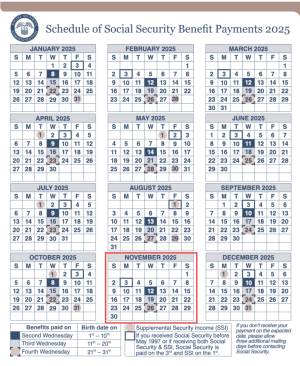Reminder: Social Security’s full retirement age is rising—here’s what to know before your next check
By
Veronica E.
- Replies 0
If you’re nearing retirement—or already receiving Social Security—there’s an important change on the horizon that could affect your monthly benefit.
For years, the full retirement age (FRA) has been slowly rising, and this fall it reaches a new milestone.
The FRA determines when you can collect your full Social Security amount, and claiming early could mean a permanent reduction.
This shift could impact when and how much you receive, especially if you were born in 1959 or later.
Now’s a smart time to revisit your retirement plan and make sure you’re set up to get the most from what you’ve earned.

The full retirement age is moving again
Not too long ago, age 65 was considered the standard retirement age for full Social Security benefits.
But thanks to changes Congress made in 1983, the FRA has gradually increased over time to reflect longer life expectancies.
Depending on your birth year, your FRA may be a little higher than you expected.
Here’s where it currently stands:
That means if you were born in 1959, you’ll reach your full retirement age just in time for the November 2025 payment cycle.
For anyone born in 1960 or beyond, the full retirement age becomes a flat 67—no more gradual increases after that.
Also read: White House responds to Social Security change concerns
Why this matters for your check
Your FRA determines when you can start collecting your full Social Security benefit.
If you claim even one month early, your benefit will be permanently reduced.
Claiming at age 62 (the earliest possible age) could lower your monthly benefit by around 30%.
That reduction adds up—especially since many people live well into their 80s or 90s.
Also read: Social Security after retirement: 6 Smart moves to make
Estimated benefits at different ages
Your Social Security benefit amount depends on your earnings history and the age you begin collecting.
Here’s a general idea of the monthly payment for someone who earned the maximum each year:
Most people receive less than the maximum, but you can get a personal estimate using the Social Security Administration’s online calculator.
Also read: Get ready for a Social Security update: When the 2026 COLA will be announced
November 2025 payment schedule
Payments are issued on Wednesdays, depending on your birth date:
Mark your calendar accordingly if you're budgeting or planning around your benefit deposit.

Also read: A Social Security case from New Jersey is raising eyebrows—here’s what happened
When should you claim?
The right time to claim Social Security benefits depends on your personal situation.
Here's a quick overview:
Your health, life expectancy, financial needs, and other income sources can all play a role in deciding when to file.
Also read: Social Security at 90: Trump administration proposals could reshape retirement for millions
What’s next for the Social Security program?
There’s ongoing concern about Social Security’s future funding, especially among Boomers.
But most experts say drastic cuts are unlikely in the near term.
Congress has made adjustments in the past to keep the program going, and Social Security remains one of the most supported benefits in the country.
Still, it’s smart to have backup plans.
Additional retirement savings, part-time work, or pension income can help if changes do occur down the line.
Also read: Millions to see Social Security checks arrive early next week
Tips to get the most from your benefits
With the FRA rising again, it’s more important than ever to understand your options and make thoughtful decisions about your Social Security benefits.
Whether you’re just starting to plan or already receiving payments, taking a few moments now can help you feel more confident about the road ahead.
Read next:

Are you planning to file soon? Have you already gone through the Social Security process? Share your story or questions in the comments. The GrayVine community is a great place to learn from others who’ve been there too.
For years, the full retirement age (FRA) has been slowly rising, and this fall it reaches a new milestone.
The FRA determines when you can collect your full Social Security amount, and claiming early could mean a permanent reduction.
This shift could impact when and how much you receive, especially if you were born in 1959 or later.
Now’s a smart time to revisit your retirement plan and make sure you’re set up to get the most from what you’ve earned.

Social Security continues to be the foundation of financial security for millions of retirees across the country. Image Source: YouTube / CBS Mornings.
The full retirement age is moving again
Not too long ago, age 65 was considered the standard retirement age for full Social Security benefits.
But thanks to changes Congress made in 1983, the FRA has gradually increased over time to reflect longer life expectancies.
Depending on your birth year, your FRA may be a little higher than you expected.
Here’s where it currently stands:
- Born in 1957: FRA is 66 years and 6 months
- Born in 1958: FRA is 66 years and 8 months
- Born in 1959: FRA is 66 years and 10 months
- Born in 1960 or later: FRA is 67 years
That means if you were born in 1959, you’ll reach your full retirement age just in time for the November 2025 payment cycle.
For anyone born in 1960 or beyond, the full retirement age becomes a flat 67—no more gradual increases after that.
Also read: White House responds to Social Security change concerns
Why this matters for your check
Your FRA determines when you can start collecting your full Social Security benefit.
If you claim even one month early, your benefit will be permanently reduced.
Claiming at age 62 (the earliest possible age) could lower your monthly benefit by around 30%.
That reduction adds up—especially since many people live well into their 80s or 90s.
Also read: Social Security after retirement: 6 Smart moves to make
Estimated benefits at different ages
Your Social Security benefit amount depends on your earnings history and the age you begin collecting.
Here’s a general idea of the monthly payment for someone who earned the maximum each year:
- Retire at 62 in 2025: $2,831/month
- Retire at full retirement age (66 years, 10 months): $4,018/month
- Delay until 70: $5,108/month
Most people receive less than the maximum, but you can get a personal estimate using the Social Security Administration’s online calculator.
Also read: Get ready for a Social Security update: When the 2026 COLA will be announced
November 2025 payment schedule
Payments are issued on Wednesdays, depending on your birth date:
- Born 1st–10th: Wednesday, November 12
- Born 11th–20th: Wednesday, November 19
- Born 21st–31st: Wednesday, November 26
Mark your calendar accordingly if you're budgeting or planning around your benefit deposit.

Planning ahead? Knowing your Social Security payment schedule can help you stay on track Image Source: SSA.
Also read: A Social Security case from New Jersey is raising eyebrows—here’s what happened
When should you claim?
The right time to claim Social Security benefits depends on your personal situation.
Here's a quick overview:
- Claiming early (age 62): You get benefits sooner, but at a permanent 30% reduction.
- Claiming at full retirement age: You receive your full benefit.
- Delaying until 70: Your benefit grows about 8% for each year you wait, up to 25% more than your FRA amount.
Your health, life expectancy, financial needs, and other income sources can all play a role in deciding when to file.
Also read: Social Security at 90: Trump administration proposals could reshape retirement for millions
What’s next for the Social Security program?
There’s ongoing concern about Social Security’s future funding, especially among Boomers.
But most experts say drastic cuts are unlikely in the near term.
Congress has made adjustments in the past to keep the program going, and Social Security remains one of the most supported benefits in the country.
Still, it’s smart to have backup plans.
Additional retirement savings, part-time work, or pension income can help if changes do occur down the line.
Also read: Millions to see Social Security checks arrive early next week
Tips to get the most from your benefits
- Check your earnings record: Make sure your reported income is accurate—errors could reduce your future checks.
- Look into spousal benefits: You may qualify for spousal or survivor benefits if you're married or widowed.
- Watch for taxes: Depending on your total income, up to 85% of your Social Security benefit could be taxable.
- Coordinate with Medicare: Medicare eligibility starts at age 65, but your FRA might be later—plan for health coverage during the gap.
- Talk to a financial advisor: A pro can help you create a personalized Social Security strategy.
With the FRA rising again, it’s more important than ever to understand your options and make thoughtful decisions about your Social Security benefits.
Whether you’re just starting to plan or already receiving payments, taking a few moments now can help you feel more confident about the road ahead.
Read next:
- Social Security launches major website redesign that could change how you manage your benefits
- Could your retirement plans handle a 24% Social Security cut in 2032?
- An important step Social Security retirees shouldn’t miss on Oct. 15
Key Takeaways
- The Social Security full retirement age is now 66 years and 10 months for people born in 1959, and 67 for those born in 1960 or later.
- Claiming before reaching your FRA permanently reduces your monthly benefit, with a 30% cut if you file at age 62.
- November 2025 payments will be issued on the 12th, 19th, or 26th depending on your birth date.
- Delaying your claim to age 70 can increase your monthly benefit by about 25% above the full retirement amount.
Are you planning to file soon? Have you already gone through the Social Security process? Share your story or questions in the comments. The GrayVine community is a great place to learn from others who’ve been there too.






